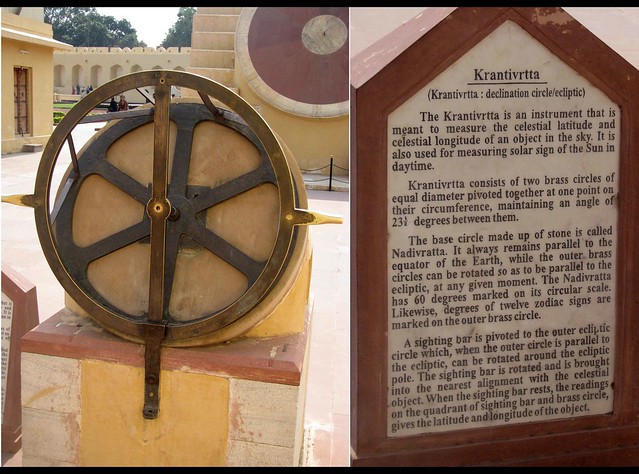N. Rathnasree, Nehru Planetarium, Nehru Memorial Museum and Library, New Delhi
(Page under construction)
The instruments of the Jantar Mantar observatories, which allow measurements of the positions of celestial objects in Ecliptic Co-ordinates, are the 12 Rasi Valaya Yantra instruments unique to the Jaipur observatory, The Krantivrtta at the Jaipur Jantar Mantar observatory and the Karka Rasi Valaya on the back wall of the Misra Yantra at the Jaipur observatory.
The annual apparent path of the Sun in the sky is the Ecliptic, which forms the basic framework of the ecliptic co-ordinate system.
The projection of Earth’s Equator in the sky, is the Celestial Equator. The Celestial Equator and the Ecliptic intersect at two points in the sky – the Vernal Equinox and the Autumnal Equinox.
The Celestial Latitude of a body in the sky is its angular distance in the direction North or South, of the Ecliptic. The Celestial Latitude is measured along a great circle passing through the body and the ecliptic poles. The Poles of the Ecliptic are two points in the celestial sphere that are 900 away from every point on the Ecliptic.
The Celestial Longitude of a body is its angular distance from the Vernal Equinox, measured along the ecliptic. The celestial longitude is measured toward the East, from the Vernal Equinox to the point of intersection between the Ecliptic and the great circle that passes through the celestial body and the ecliptic poles.

The twelve Rasi Valaya instruments of the Jaipur Jantar Mantar observatory
The Krantivrtta is an instrument that can measure the ecliptic co-ordinates - Celestial Latitude and Celestial Longitude.

Krantivrtta instrument at the Jaipur Jantar Mantar observatory
The Krantivrtta at this location in the observatory was built during the 1901 renovation of the observatory, as the original masonary krantivrtta (near the entrance to the observatory) could not be completed.
The Krantivrtta is an interesting instrument that can determine the Celestial Latitude and Celestial Longitude of an object in the sky. The instrument consists of two brass circles, one representing the Celestial Equator and the other representing the Ecliptic. The two circles are mounted with an inclination of 230 27/ between them, which is the angle between the Celestial Equator and the Ecliptic.
The inner brass circle is always parallel to the equator of the Earth, while the outer brass circle can be rotated so as to be parallel to the Ecliptic, at any given moment.
There is a sighting bar that is pivoted to the ecliptic ring, which, in the position when the outer circle is parallel to the ecliptic, can be rotated around the ecliptic pole. The sighting bar is rotated and is bought into the nearest alignment with the celestial object. The reading on the ecliptic ring, where the sighting bar rests, gives the Ecliptic Longitude of the object.
There is a quadrant attached to the sighting bar. There is a smaller sighting bar with this quadrant, which when aligned exactly towards the celestial object, allows one to read the celestial latitude of this object on the quadrant scale.

The Karka Rasi Valaya on the backwall of the Misra Yantra at the Delhi Jantar Mantar observatory
(To be completed)